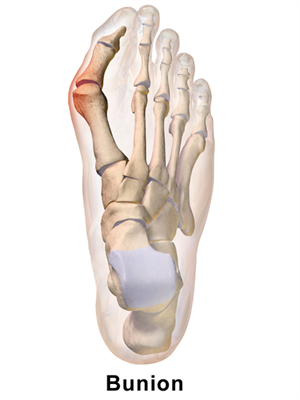If you are suffering from toe pain and are ruling out a bunion simply because you think they only happen to the young professionals wearing pointy high heeled shoes, you could be mistaken.
Bunions can form from an inherited structural issue in the foot or as a result of medical conditions like arthritis. Inflammatory or degenerative arthritis can cause the cartilage covering the big toe joint to deteriorate and places extra pressure on the joint that over time forms a bunion. Even if arthritis does not erode the cartilage, it could change the way you walk due to the pain, which may cause the formation of a bunion.
What exactly is a bunion?
A bunion is bony knob that forms on the joint at the base of the big toe. It usually comes about after an extended period of time where the big toe has been pushed against the other toes either by wearing shoes with a small toe box or due to a fault in the structure of the foot. One can also develop bunionettes on the joints of the smaller toes.
Symptoms of a bunion
Besides the bony bump on the side of the big toe base, one might experience swelling, redness and pain around the big toe joint. It is also common to have thickened skin or corns and calluses at the base of the big toe. Restricted movement in the big toe is another symptom along with overcrowding in the shoe due to the nodule.
How to manage with a bunion
The problem with bunions is that once they are there, they can only be removed through surgery. Therefore, it is paramount to take preventative action. Choose shoes that allow your feet to be in the same position as if you were barefoot. Avoid high heels since they push the toes together and create additional pressure on the big toe joint.
Because the bursa in the joint can become inflamed, bunions can be very painful. Control the pain with ibuprofen or other anti-inflammatory medications. Using an ice pack two to three times daily can reduce swelling. If the pain and swelling persists, cortisone injections might be helpful. A podiatrist can help with padding or taping the foot in a normal position if needed. Bunion pads are also available over the counter, and arch supports and other shoe inserts can provide relief as well as prevent a bunion from worsening. Surgery is truly only considered if the bunion is interrupting your daily life because a new bunion could develop post surgery and/or pain could still be present.
Don’t think you are immune from a bunion just because you don’t wear pointy high heeled shoes. A bunion can form early or late in life from a variety of genetic and non-genetic factors.
Information taken from: http://www.mayoclinic.org/diseases-conditions/bunions/home/ovc-20262028
Carrie Robertson
Research & Community Education
Chicago Skilled Nursing
Chicago Senior Living

